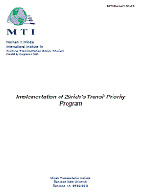- 408-924-7560
- mineta-institute@sjsu.edu
- Donate
Implementation of Zurich’s Transit Priority Program
The objective of this research was to describe transit priority techniques in Zürich and understand how the city implemented its program. Most transit priority improvements are relatively simple and inexpensive; however, they have proved to be difficult to implement and sustain. The research effort consisted of a case study with interviews and surveys. We interviewed many persons associated with the development and implementation of Zürich’s transit priority program. A survey to evaluate support of transportation decision-makers in Santa Clara County, California, illustrated transit improvements in a typical U.S. city. The data was compared to a similar survey in Zürich. The findings help us to understand how elected officials think about transit improvements.
Zürich is famous for the quality of its public transit system and it has one of the highest levels of per capita transit ridership in the world. This is because its transit service is fast, frequent, reliable, and inexpensive, due in large part to its transit priority program. The research describes transit priority techniques implemented in Zürich and discusses the relevance of the Zürich experience to other cities interested in developing similar systems, highlighting the unique benefits and challenges of a transit priority system. Transit priority improvements are relatively low-cost ways to make a transit system work better by reducing vehicle delays. Specific improvements fall in the following categories: roadway improvements and traffic regulations, traffic signal preemption, exclusive transit lanes, transit malls, transit system operations, transportation system improvements, major transit facilities, and bus rapid transit. Zürich’s experience offers valuable insight to the process of developing and sustaining a transit priority system. These insights include: the importance of public support, planning land use to support transit use, implementing improvements comprehensively, interdepartment coordination, leveraging institutional change, and adopting appropriate technology. Ultimately, what is important is that Zürich’s transportation system is a major contributor to the city’s high quality of life and livability. Cities interested in implementing transit priority systems can learn much from Zürich’s experience and be encouraged by its success.
ANDREW BUTLER NASH, PE
Andrew Butler Nash is an independent transportation planning and engineering consultant. He is the former Executive Director of Transportation Planning for the San Francisco County Transportation Authority. Nash formerly served as a Project Manager for Caltrain and as a Manager at the Santa Clara County Congestion Management Agency. He is a registered professional civil engineer and obtained his Master of Engineering and Master of City Planning degrees at the University of California, Berkeley, where he focused on transportation policy. He also has a Master of Science in Civil Engineering from Northeastern University, where he specialized in transit operations.
Nash has been active in several San Francisco area nonprofit organizations, including serving as President of the Bay Area’s Greenbelt Alliance and as a Director of the San Francisco Planning and Urban Research (SPUR). Nash ran for election to the Bay Area Rapid Transit (BART) District Board of Directors in 1992.
-
Contact Us
San José State University One Washington Square, San Jose, CA 95192 Phone: 408-924-7560 Email: mineta-institute@sjsu.edu






